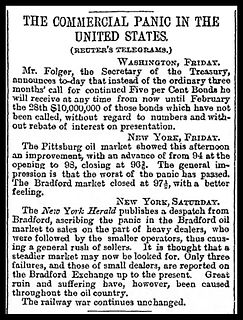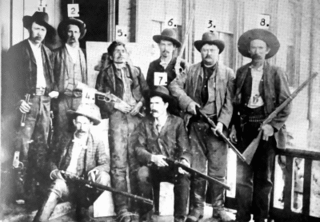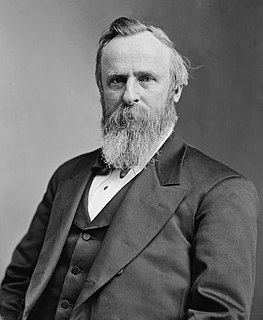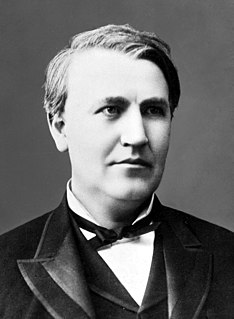 W
WThis section of the Timeline of United States history concerns events from 1860 to 1899.
 W
WThe Depression of 1882–1885 or Recession of 1882–1885 was an economic contraction in the United States that lasted from March 1882 to May 1885, according to the National Bureau of Economic Research. At 38 months in length this is the third-longest recession in the NBER's chronology of business cycles from 1854 to present. Only the Great Depression of 1929–1941 and the Long Depression of 1873–1879 were longer.
 W
WThe history of the United States from 1865 until 1918 covers the Reconstruction Era, the Gilded Age, and the Progressive Era, and includes the rise of industrialization and the resulting surge of immigration in the United States. This article focuses on political, economic, and diplomatic history.
 W
WNed Christie's War is a phrase that has been used when referring to the overall confrontation between American lawmen and the Cherokee renegade Ned Christie. After Deputy Marshal Daniel Maples was shot to death in May 1887, Christie was accused of being responsible for the murder, so he fled to a remote area of the Cherokee Nation. For five years Christie eluded the posses that came after him, mostly with the help of friends and family. However, in November 1892 a well-armed force of lawmen breached his stronghold and killed him.
 W
WThe New England Manufacturers' and Mechanics' Institute flourished in the 1880s in Boston, Massachusetts. It existed as a rival to the long-established Massachusetts Charitable Mechanic Association. Individuals affiliated with the NEM and M Institute included businessman John F. Wood, James L. Little, John M. Little, Samuel R. Payson, William B. Merrill, and Frederick W. Griffin.
 W
WThe presidencies of Grover Cleveland lasted from March 4, 1885 to March 4, 1889, and from March 4, 1893 to March 4, 1897. The first Democrat elected after the Civil War, Grover Cleveland is the only President of the United States to leave office after one term and later return for a second term. His presidencies were the nation's 22nd and 24th. Cleveland defeated James G. Blaine of Maine in 1884, lost to Benjamin Harrison of Indiana in 1888, and then defeated President Harrison in 1892.
 W
WThe presidency of Benjamin Harrison began on March 4, 1889, when Benjamin Harrison was inaugurated as President of the United States, and ended on March 4, 1893. Harrison, a Republican, took office as the 23rd United States president after defeating Democratic incumbent President Grover Cleveland in the 1888 election. Four years later he was defeated for re-election by Cleveland in the 1892 presidential election. Harrison is the only president to be preceded and succeeded by the same individual. Harrison is also the only president to be the grandson of another president.
 W
WThe presidency of Chester A. Arthur began on September 19, 1881, when Arthur became the 21st President of the United States upon the assassination and death of President James A. Garfield, and ended on March 4, 1885. Arthur, a Republican, had been Vice President of the United States for only 199 days when he succeeded to the presidency. In ill health and lacking the full support of his party by the end of his term, Arthur made only a token effort for the Republican nomination in the 1884 presidential election. He was succeeded by Democrat Grover Cleveland.
 W
WThe presidency of Rutherford B. Hayes began on March 4, 1877, when Rutherford B. Hayes was inaugurated as President of the United States, and ended on March 4, 1881. Hayes became the 19th president, after being awarded the closely contested 1876 presidential election by Republicans in Congress who agreed to the Compromise of 1877. That Compromise promised to pull federal troops out of the South, thus ending Reconstruction. He refused to seek re-election and was succeeded by James A. Garfield, a fellow Republican and ally.
 W
WThe Waite Court refers to the Supreme Court of the United States from 1874 to 1888, when Morrison Waite served as the seventh Chief Justice of the United States. Waite succeeded Salmon P. Chase as Chief Justice after the latter's death. Waite served as Chief Justice until his death, at which point Melville Fuller was nominated and confirmed as Waite's successor.
 W
WThe war of the currents, sometimes called battle of the currents, was a series of events surrounding the introduction of competing electric power transmission systems in the late 1880s and early 1890s. It grew out of two lighting systems developed in the late 1870s and early 1880s; arc lamp street lighting running on high-voltage alternating current (AC), and large-scale low-voltage direct current (DC) indoor incandescent lighting being marketed by Thomas Edison's company. In 1886, the Edison system was faced with new competition: an alternating current system developed by George Westinghouse's company that used transformers to step down from a high voltage so AC could be used for indoor lighting. Using high voltage allowed an AC system to transmit power over longer distances from more efficient large central generating stations. As the use of AC spread rapidly, the Edison Electric Light Company claimed in early 1888 that high voltages used in an alternating current system were hazardous, and that the design was inferior to, and infringed on the patents behind, their direct current system.